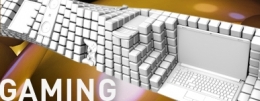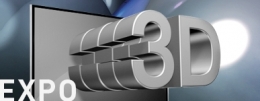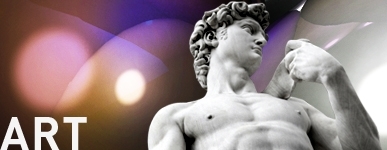
3D-Art
University of Arts and Design Karlsruhe (HfG)
3D art needs space – especially for unbounded ideas and their realisation. The exhibition gives students of the HfG and co-operating universities an extraordinary platform to exhibit their own 3D media art. Amongst others, seven students from the KHM (Academy of Media Arts Cologne) will be permitted to present their works. Holograms, 3D projections and stereoscopic images will be shown. A 3D live performance awaits the audience as well.
ZKM
As a forum for multimedia-based developments in art the Center for Art and Media Karlsruhe (ZKM) will show the developments of 3D art from different perspectives. In the ZKM's foyer a Rosalie installation involving the Sound dome will take place. In the ZKM_Cube very diverse 3D installations can be observed, among them "Sonori morphe" and "Scanline". During the entire festival, the ZKM_Media Theater will be playing 3D film art.
KHM
The Academy of Media Arts Cologne (KHM) was opened in 1990. It offers a nationwide one-of-a-kind educational concept that merges the sections film, art, and science into one diploma course entitled Medial Arts. This makes the KHM an art school that seeks altercation with media and a film school that emanates from the artistic moving image.
"Vier Jahreszeiten"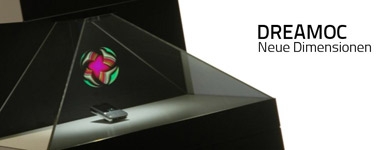
The Dreamoc™ is a inimitable 3D display that conveys information in a way that is guaranteed to have the viewer spellbound. Dreamoc™ offers a sensational combination of holographic displayal and video images with the unique possibility of letting three-dimensional information circumflow real products.
The Dreamoc installation is presented to you by rent4event and PXNG.LI..
-1/MinusEins / Experimentallabor
at the Academy of Media Arts, Cologne
The artworks presented by -1/MinusEins / Experimentallabor use light to blur the materiality of the surface. Each installation plays on different aspects of perception to produce an augmented, ephemeral and sometimes haunted sense of dimensions.
"a layer of light"

Mader | Stublić | Wiermann consists of two media artists, Holger Mader and Alexander Stublic, and an architect, Heike Wiermann. Their central theme is to investigate mechanisms of perception in public space. By extending architecture as a stereoscopic medium to embrace time-bound media - such as light, video and sound - they create novel possibilities in experiencing urban environments.
They exhibited at the ZKM Karlsruhe, at Kunsthalle Baden-Baden, Kunsthalle Mannheim and realized video and light projects in public space such as "twists and turns" on the LED surface of the Uniqa Tower in Vienna (since 2006), on the "seven screens" in Munich (2006 and 2010), "expanded space" for the UN Climate Conference Copenhagen (2009), three installations for the Ruhr.2010 European Capital of Culture.
They also participated in international festivals like Mostra des Artes São Paulo, Glow Festival Eindhoven, the Steirischer Herbst, the Filmfestival Seoul, viper, tansmediale.
Mader | Stublić | Wiermann live and work in Berlin
www.webblick.de

"French Connection"
The french firm Alioscopy will be presenting auto-stereoscopic Full HD-Videoscreens at the BEYOND festival that allow the visitor to experience 3D video animation from cinema and advertisement without special 3D glasses. The inventor of the process named after him, Pierre Allio, will be presenting this with relief-photographs that will be shown to the public for the first time: landscapes, studies of nudes, and still lifes.
The German photo artist Mark Blezing uses the possibilities of Alioscopy in a breath-taking way to create "film stills" of a phantastic dream world. A selection of his "Back to Modern Myth" series (2005-2011) will be shown.
http://www.alioscopy.com // http://www.blezinger.com
"Evolutionary Lines"
The presentation "Evolutionary Lines" lets one ostensibly relive evolution. The interactive installation offer a 3D environment that allows one to observe the development of life in motion. The creature changes can be experienced in real time. The objects can be viewed from all sides. The animal appears as if it were floating in space. The individual body elements of the animals can be separated and studied more closely. The "holographic 3D effect" of Eyeliner is an enhancement of Professor John Henry Pepper's "Pepper's Ghost" principle from the 19th century. It is described as being one-of-a-kind and dynamic, offering wholly new possibilities in transfering the contents of new media.
Developbed by Prof. Dino Frey, Contexts-Relationen and PXNG.LI for 3D-Beyond, supported by rent4event.
www.evolutionslinien.de
"EXPANDED CITY"
The visitor playfully deals with a new form of Augmented Sculpture:
With a joystick he gains control over a game figure that helps him compose electronic music with an interplay of colours and forms. Through the expansion of the action into real space the principles of classic arcade games are brought onto another level. In the game space virtual and real world flow together and become one.
Lab.D Group work, Kunsthochschule für Medien Köln (KHM): Jonas Hansen, Katja Harms, Gerald Schauder aka Kabelton, Gabriel Vanegas
http://expanded-image.blogspot.com/
"Polyphonia - Four-part Ambient Sound with 3D Projection"
The chamber choir Cantus Solis Karlsruhe under direction of Anja Daecke, the chamber choir Ettlingen under direction of Ralf Keser and the ZKM media artist Bernd Lintermann invite you to the catholic church "Unserer Lieben Frau" in Karlsruhe's south city on May 22nd 2011 around 8:30 PM.
Performance of the up to 40-part choir pieces with the Motette Spem in alium by Thomas Tallis (~1505-1585) in combination with animated computer graphics in the newest 3D technology. Animations, in which many different geometric shapes grow together into one big moving image, correspond with a sound experience that brings out the many, completely self-contained voices.
"The Karlsruhe Moviemap" (2009)
"The Karlsruhe Moviemap" is an interactive installation that was conceived by Michael Naimark in 1991 with which users can explore the light-rail system of Karlsruhe. In 2009 it was revise with new technologies and changes of the light-rail system.

With the help of a control level and touchscreens users can ride on selected sections of the light-rail system. On the screen in front of them stereoscopic and documentary image sequences appears along Karlsruhe's light-rail lines. The thematic origin of the installation was the perfect illusion of drive or flight simulators as they have been developed for military and civil purposes. Contrary to this users of the moviemap are not free to move around as they wish within virtual Karlsruhe. The point of view and direction stay stuck to a real infrastructure - the light-rail system.
A work of Michael Naimark.
"The Fruit Machine" (1991)
The basis of this interactive stereoscopic installation is the visual and playful characteristics of a gaming machine. Unlike one is used to, one can only "win" with combined efforts. If the communication between the three players fails, the arrangement remains fragmentary.

Through successful communication however individual components can be set together to one piece with the help of 3D controlling levers - a virtual money shower is the reward.
A work of Agnes Hegedüs.
Boris Petrovsky: »You&Me-isms / part I«
Interaktive Installation
SubRaum des ZKM_Kubus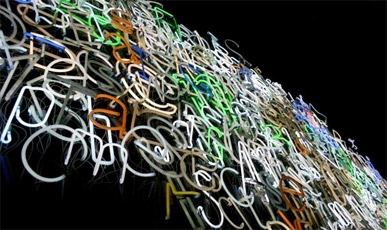
Drawing from analogue technologies, such as optical telegraphs, telex machines, and advertising media, You&Me-isms is an idiosyncratic cyber punk communication machine. Visitors are asked to interact as users, with a message via SMS or Twitter. Their messages then appear as an illuminated path of signs in the blip matrix, where they cross over with web news feeds. The chaotic, complex network of 450 neon signs is literally attributed sense (or nonsense) and lent an apparent structure. A confrontation with and inquiry into the construction of reality characterize the installation and art and architecture projects of media artist Boris Petrovsky (born 1967 in Konstanz).
www.petrovsky.de
"You&Kraut-isms"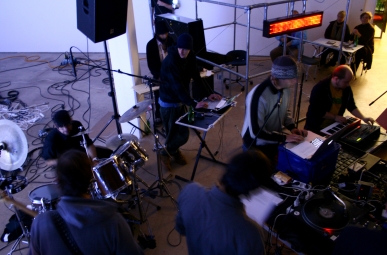
The music performance is simultaneously the closing event for "You&me-isms / part I" in the ZKM_Sub Room, the "Cyberpunk Communication Machine" by Boris Petrovsky, consisting of 440 neon-light letters and processors that recieves messages via SMS and through the internet and displays them in the matrix. In an interplay of man and machine the KlangZeichenRaum ("Sound-Symbol-Space") is opened. A place in the hyperspace of our perception, where meaning and noise is made out of thoughts and feelings. For this purpose Krautfass3000 intentionally work without practiced pieces and arrangements. Following a "stream of consciousness" all performers become constructors and deconstructors of the moment. Similar to a DJ-set each track glides into the following one. Attention, interactive installation! Programmer Georg Nagel will hack himself into the matrix (live) and control the output of just received messages from visitors in accordance to the synaesthetic noise of the lighting signals.
A performance of the Band Krautfass3000 with artist Boris Petrovsky and the visitors as users.
www.petrovsky.de
"Stairwell"
Stairwell is a cinematic dance installation in 3D that originated through a cooperation of media artists from the OpendEnded Group and the British choreograph Wayne McGregor. In the installation dance can be perceived in a new way - the 3D images floating in space almost seem to be tangible to the visitor. They show the performance of McGregor as well as the archictectural environment in which it took place. In their abstractness the visualisations are nonetheless hard to grasp - the images have no sharp outlines, the abstracht forms of human movement and architecture flow together.
A workd of the OpenenEndedGroup.
"Juxtaposition"
In Juxtaposition stereoscopic 3D panoramas, recorded in the Tasmanian wilderness, are contrasted with scenes of extreme urbanisation in Hong Kong. The points of contact are shaped as crossovers of the worlds and open unfamiliar perspectives on the area of conflict between nature and urban development.
A work of Volker Kuchelmeister.
"Deconstructing Double District" (2011)
Deconstructing Double District combines the visualisation of a dance scene in stereo 3D accompanied by atmospheric sounds. The result is an endlessly transforming three-dimensional abstrakt form that is generated in real time and can modified through user input. To go along with the parameterised sound are created and distributed in the space above the ZKM Klangdome.
Deconstructing Double District is based on the stereoscopic video footage of the installation "Double District" by Saubro Teshigawara (2008).
A work of Volker Kuchelmeister
Music: Ludger Brümmer
"Sea of Tranquility"
The "Sea of Tranquility", a sea on the surface of the moon, served as a landing area for the first manned mission to the moon Apollo 11 on July 20th 1969. Holger Förterer processes the aerograms of this historic mission into a flight through a sea of language.
The instruments of this work are a multi-channel surround sound and a 3D projection in the adapted PanoramaLabor of the ZKM. Every single projected dot in the screen is an individual voice in the total sound pattern.
A work of Holger Förterer.
